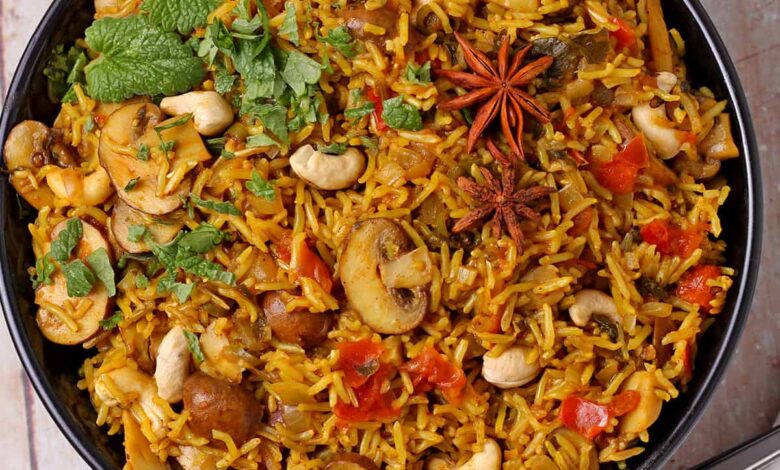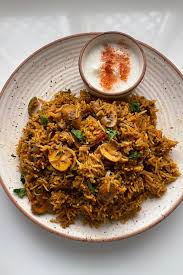Mushroom Biryani Recipe
Mushroom Biryani Recipe

Mushroom Biryani Recipe Introduction
Mushroom biryani is a delicious, fragrant, and hearty dish featuring basmati rice, mushrooms, aromatic spices, and herbs. It’s an ideal vegetarian main course that’s packed with flavor, texture, and is satisfying to serve for special occasions or a cozy family meal.
Recipe Overview
This mushroom biryani recipe includes spiced mushrooms, fluffy basmati rice, and a blend of traditional Indian spices. Each layer of rice and mushrooms is cooked to perfection, creating a one-pot dish that’s bursting with rich, earthy flavors.

Mushroom and Cheese Omelette Recipe:
A Quick and Tasty Breakfast
If you’re searching for a simple yet satisfying dish, a mushroom and cheese omelette is a must-try. Bursting with flavors and textures, it’s perfect for a hearty breakfast, brunch, or even a light dinner. Follow this recipe to whip up a restaurant-quality omelette in no time.
Mushroom and Cheese Omelette
To make the perfect mushroom and cheese omelette, you’ll need these.
ingredients:
3 large eggs
1/4 cup sliced fresh mushrooms
1/4 cup grated cheese (cheddar, Swiss, or your favorite variety)
1 tablespoon unsalted butter (or olive oil for a lighter option)
Salt and black pepper to taste
Fresh parsley or chives (optional, for garnish)
Step-by-Step Recipe Instructions
Step 1: Prep the Mushrooms
Start by heating a non-stick skillet over medium heat. Add the butter and let it melt. Toss in the sliced mushrooms and sauté them until they become golden brown and tender. Once done, remove the mushrooms from the pan and set them aside.
Step 2: Whisk the Eggs
In a bowl, crack the eggs and whisk them until well combined and slightly frothy. Season with a pinch of salt and pepper for flavor.
Step 3: Cook the Egg Base
Heat the same skillet on medium heat. Add a little more butter if needed. Pour in the whisked eggs and gently swirl the pan to spread them evenly. Allow the eggs to cook undisturbed until the edges begin to set, but the center remains slightly runny.
Step 4: Add the Fillings
Spread the sautéed mushrooms over one half of the omelette. Sprinkle the shredded cheese on top of the mushrooms. Let the heat melt the cheese slightly while the eggs continue to cook.
Step 5: Fold and Serve
Using a spatula, carefully fold the omelette in half to enclose the fillings. Slide it onto a plate and garnish with fresh parsley or chives for a pop of color.
Pro Tips for a Perfect Omelette
Use Fresh Ingredients: Fresh mushrooms and good-quality cheese make all the difference.
Don’t Overcook: Cook the eggs just until they’re set for a creamy texture.
Non-Stick Pan: A non-stick skillet ensures easy flipping and prevents sticking.
Season Lightly: Remember, the cheese adds saltiness, so adjust seasoning accordingly.
Why You’ll Love This Recipe
This mushroom and cheese omelette is:
Quick: Ready in under 10 minutes, perfect for busy mornings.
Customizable: Add herbs, onions, or spinach to suit your taste.
Nutritious: Packed with protein, vitamins, and minerals to fuel your day.
Nutritional Highlights
Mushrooms: Rich in antioxidants and vitamins like B and D.
Cheese: Provides calcium and a creamy, indulgent flavor.
Eggs: A great source of high-quality protein and essential nutrients.
Serving Suggestions
Pair your omelette with:
Whole-grain toast for a wholesome breakfast.
A fresh green salad for a balanced brunch.
Roasted potatoes for a hearty meal.
Conclusion
A mushroom and cheese omelette is the epitome of comfort food that’s easy to make and always satisfying. Whether you’re cooking for yourself or impressing guests, this recipe is sure to be a hit. Try it today and enjoy every cheesy, savory bite!





